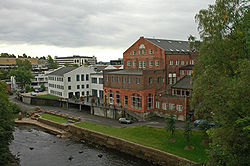Lysaker, Norway
| Lysaker | |
|---|---|
| Town | |

Sections of Lysaker viewed from the bridge over Granfossen, Lysaker
|
|
| Country | Norway |
| Region | Østlandet |
| County | Akershus |
| Municipality | Bærum |
| Time zone | CET (UTC+01:00) |
| • Summer (DST) | CEST (UTC+02:00) |
| Post Code | 1324-1327 and 1366 |
Lysaker is an area in Bærum municipality, Akershus county, Norway. Lysaker is the easternmost part of Bærum, and borders Oslo proper. Lysaker was initially a farming community, later becoming a residential area. Today it is primarily known as a business and trade area, and a public transport hub. It is considered part of Stor-Oslo (Greater Oslo), and is home to offices of numerous domestic and international businesses.
Lysaker is located where a stream, Lysakerelva, empties into Lysakerfjorden—a branch of the Oslofjorden. This stream is the western border of Oslo proper.
To the south-east Lysaker is bordered by the fjord. To the south-west is the Fornebu area, where one of Oslos two airports were located until Oslo Airport, Gardermoen, was expanded in order to handle all the traffic alone. To the west and north are the primarily residential areas of Stabekk and Jar. To the east is Sollerud and Lilleaker in Ullern borough.
Lysaker, meaning "bright acres" was originally the name of a farm. Its buildings were located along the fjord on the western bank of the river, where today there are business headquarters. In 1624, with the establishment of the Kongsberg Sølvverk (Kongsberg Silver Mines) a road was built through the area, leading directly to central Oslo, and a bridge was built over the stream approximately where today's bridge is located. This led to economic development and increased settlement for in area.
In 1872 the railroad to Drammen was built, passing through the Lysaker area and crossing the stream, where a station was built. This led to further increase in business and settlement and was the beginnings of Lysaker as a transport hub.
By the 1900s Lysaker was a primarily residential area, and its main claim to fame was that the polar explorer Fridtjof Nansen took up residence there. He built a house he called Polhøgda, and lived there until his death in 1930, upon which he was buried on the grounds. Today Polhøgda houses the Fridtjof Nansen Institute, and tours of the premises are available. Simultaneously, Lysaker was home to "Lysakerkretsen" (The Lysaker Circle), a name coined for a group of artists and intellectuals who resided there in the early 1900s.
...
Wikipedia
